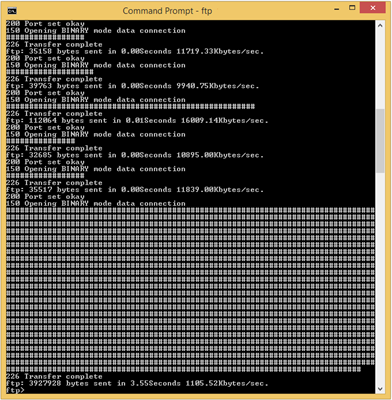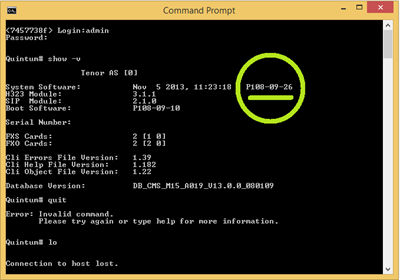Sonus has released a January update for the Tenor family, taking it from P108-09-23 to P108-09-26.
There are a handful of fixes, as well as some new values added to var_config.
Here’s an extract of the latest changes from the Readme document, which you can Download.
Resolved Issues/Feature Enhancement
P108-09-26
4929 CID feature works in Receive Direction only
The E&M Caller ID feature implemented by MR 4923 worked in Receive Direction only. When the Tenor made outgoing calls, it sent only DNIS, independent of configuration. This has been resolved.
P108-09-25
4928 GUI does not connect to Analog Tenors running P108-09-24
When MR 4923 (E&M Caller ID feature) was added to the Tenor DX, it caused the Tenor Configuration Manager to not connect with the Analog Tenors. As a work around, enable the feature changes in the CLI database for Digital Tenor only, not Analog.
P108-09-24
4920 SIP Decode failed when CallID had % character
When the Tenor decoded the CallID header and found a % character present, it would interpret the character (rather than taking it as a literal character). As a result, the Decode failed. This has been resolved.
4921 No ISDN Connect message for 911 calls
Some T1/ISDN carriers do not provide an ISDN level connect message for 911 calls. As a result, the Tenor never sent a 200Ok message to the SIP side to connect the call. A new feature enables you to configure up to 8 phone numbers for mapping of ISDN Progress to SIP connect. Each phone number handles a maximum of 16 digits. This feature is applicable only for calls coming into SIP and out ISDN (Trunk/ISDN). The DN specified is used to match against the final translated DN (not the original incoming DN) that is sent out on the DN side.
A new varconfig file is available to support this feature: mapIsdnProgressToSipConnectDN1 DN1 (where DN1 indicates the DN number).
4922 IP to IP Calls: Unsupported Codecs in the SDP caused unexpected behavior
If the Tenor was configured for IP to IP calls and if the originating IP device/phone had any codecs in its profile that the Tenor’s DSP did not support, the incoming SIP invite caused the Tenor to crash and reboot. This has been resolved.
4923 Calling Party Number (Caller ID) support in CAS E&M
Although the current CAS E&M implementation does not support receiving and sending of ANI (calling party number), new configuration options are included for E&M to support a modified DNIS that includes ANI.
To support this feature, the following new configuration items are available for the CLI only (not available in the Tenor Configuration Manager) under CASSG-1:
ENMAniDnisSequence
ENMStartDigit
ENMAniDnisDelimiter
ENMEndDigit
For detailed information about the commands, see the Command Reference Guide.
4924 Three Beeps when making outgoing call via Tenor DX
When a call was made from a Lync Mediation Server, a user would receive three quick beeps when making any outbound call from the Tenor DX before the user on the Lync client side heard any ring back. This has been resolved.
4925 T.38 offered in reInvite to Tenor, but Tenor chose G.711ulaw instead
When a Tenor was making an outbound fax call through a SIP Trunk, and a T.38 in the INVITE was returned, the Tenor chose G.711ulaw instead of T.38 and the fax subsequently failed. The Tenor was unable to re-negotiate media when it received a ReInvite that put the Tenor on hold. A new var_config item is now available that configures the Tenor to accept and negotiate media change on a ReInvite even if it indicates Hold.
To enable a Tenor to negotiate for a ReInvite that puts the Tenor on hold, a new varconfig configuration option is added: sipNegotiateMediaOnHold.
4927 R2 ANI Collection more than once (Applies to Tenor Digital only)
Under certain conditions the Tenor would attempt to collect ANI more than once, causing an R2 call to fail. This has been resolved.
Upgrade
I’ve always found the DOS process the easiest way to upgrade these, and it remains unchanged for this release:
- Unzip the software update into a new or empty directory
- Launch a Command Prompt
- Navigate to the folder that the new firmware is in
- FTP to the Tenor and login
- Enter the following commands in sequence
- bin
- hash
- prompt
- mput *.* [allow around 60-80s for this on a local network – don’t freak if it looks like the process has locked up – just wait]
- get reset.sys [ignore the “File “reset.sys” not found or permission problem” error – it’s rebooting!]
Done! After the box has rebooted, telnet to it and “show –v“ to confirm the new version. (You did back it up first, didn’t you?? “show –l”).
– G.






Hi Greig, Am using a quintum DX2060 for call termination through an ISDN line, a task which the discontinued tenor is doing very well.. i need assistance in setting up that any inward ISDN calls are routed to an IVR server. Thank you and kind regards.